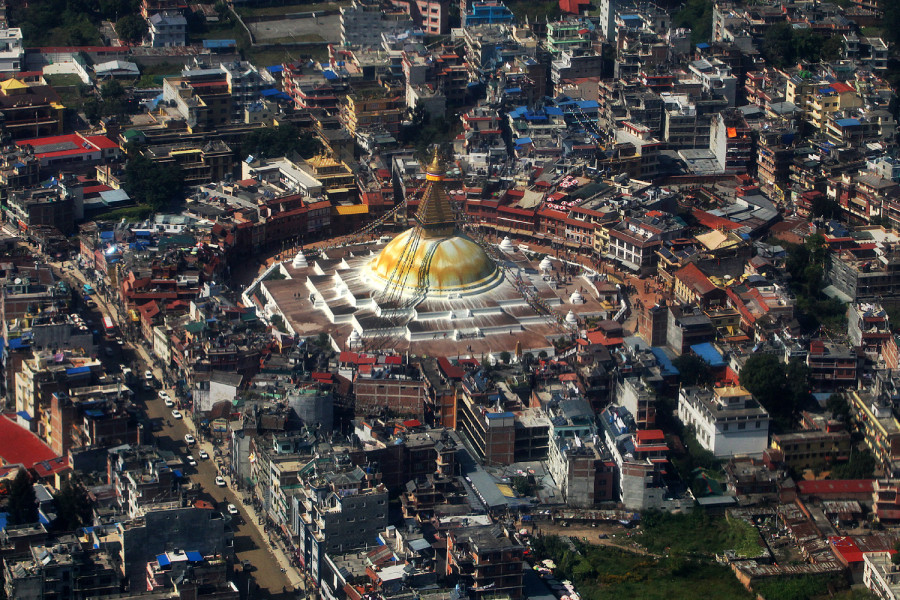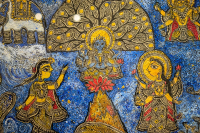Culture & Lifestyle
Breaking down the concept of the mandala
The mandala is used everywhere in Nepali culture, but many are unaware of what it signifies
Srizu Bajracharya
In the ancient days, long before Nepal was mapped in the world, the Kathmandu Valley was known as Nepal Mandala. One of the verifications for this is a Gyaneshwar inscription that dates back to the reign of Jayadeva Malla in the 13th century that mentions the Kathmandu Valley as a mandala. It is also believed that the valley is in the form of Cakrasamvara—the most important Buddhist esoteric deity that is surrounded by the sites of eight Bodhisattvas.
Over time, the presence of mandalas in the Kathmandu Valley spread—especially in the Buddhist community. Even Pancha Buddha, the five celestial Buddhas which is represented widely in mandalas, are omnipresent in the valley. With changing times, mandalas have now morphed into commercial business products and its prints can be seen in paubhas, thangkas, even t-shirts. But, what is a mandala and what do they signify?
Often pronounced as ‘manda’ in Nepal Bhasa, the mandala embodies the principle of life. “Mandala is made from two words: manda and la,” explains Yagya Man Pati Bajracharya, a Buddhist scholar. The ‘manda’ means principle and the ‘la’ means water, which flows between those principles, making a boundary; the two elements theorise how everything is woven in a rationale and has confinements. Mandala in its basic form is a circle, but it can also take the form of other shapes, such as square, rectangle, triangle, or semi-circle.
“You can also understand the mandala as a mansion of a tantric deity built in the Vajrayana concept; it is a circle that preaches how to obtain bodhichitta,” says Tika Sherpa, a Tibetan translator and cultural expert.
In the Newar community, however, making mandalas is a ritualistic concept passed on through generations.
“Almost every puja that we do involves worshipping the mandala, like in Mha puja; however, many are still unaware of the concept behind it,” says Sarvogya Bajracharya, a Newar priest.
Starting right after the birth of a child, in Janko (rice feeding ceremony of the child), families worship gurumandala praying the child has a healthy growth. The gurumandala is also a common ritual performed at the beginning of every puja which comprises of honouring and summoning the ‘guru’, an embodiment of Vajrasattva and the triple gems: the Buddha, Dharma and Sangha.
Similarly, in coming-of-age ceremonies like Ihi and Bahra Tayegu for girls, the sole rite of the ceremonies involves worshipping garbhamandala—for the healthy development of their body so that the girls can later develop a strong womb.
In the Newar culture, the mandala is an ever-present concept in the heritage of Newars, with varying mandalas particular to different festivals like Rato Machhindranath Jatra, Indra Jatra, Mha Puja, and various death rituals.
The mandala is purely based on science and represents the formula of five: solidity, liquidity, mobility, heat, and ether—implying the five elements of life: earth, water, air, fire, and space. Similarly, the mandala also represents the five senses of all living beings, says Bajracharya.
The most apparent distinction of these implications is visible in the chaityas in the Valley that have the Pancha Buddha facing five directions: Vairochana, Akshobhaya, Amitabha, Ratnasambhava, and Amoghasiddhi that point out to Central, East, West, North, and South respectively, and represents the five elements, the five senses and so forth. The five elements of the world is also represented by the five celestial female deities who are the consorts of the Pancha Buddha.

“The Swoyambhu is an example of the science behind mandala. Don’t you think it encircles solidity, liquidity, air, and heat in its dome?” asks Bajracharya.
“Mandala is a Buddhist concept where the deities are a mere representation of faith,” says Bajracharya. The mandala represents the essence of the world and reminds in symbols the virtue of life.
“The concept of worshipping is not to please ‘god’, instead it is to heed consciousness; it is praying for mental peace, for joy, and in doing so, all of us project the deity inside the mandala,” adds Bajracharya.
However, for Sarvogya Bajracharya, who has been performing pujas all his life, his practice believes in the existence of various gods. “Worshipping has always brought peace in me; I have always felt happier doing it, be it for myself or other families,” says Sarvogya.
But, unlike the Newars, the Tibetans use mandalas only for particular occasions. Making mandalas is only allowed to high priests and practitioners, says Tika Sherpa. The sand mandala ‘dupchhoe’, which is the most common Tibetan mandala that people are familiar with, is believed to have been introduced by the Buddha himself to Bodhisattvas to empower their tantric abilities.
The sand mandala is made on the ground by a high practitioner of Vajrayana using a copper tube, then colour powders are filled in slowly to fill the pattern of the mandala. The process takes almost an entire day, sometimes more, and hence is prepared a week ahead of festivals like Buddha Jayanti, Deva-avataran, and Dharmachakra Pravartan. But shortly after the mandala is finished, it is smeared off signifying the impermanence of life and the universe.
“Not everyone can make dupchhoe. The sand mandala is very sacred and is usually only made in monasteries, but of course followers can observe this process and be part of the positive energy the process creates,” says Sherpa. However, the meaning of the mandala in its essence remains the same for both Newar and Tibetan Buddhists.
“The most significant knowledge the mandala foregrounds is that of impermanence and interdependent arising, which is the same for both us and Newars,” says Sherpa. The mandala ‘kilkhor’ in Tibetan language manifests that everything in this world is interlinked and exists only because of the presence of the other.
Hawa cha ta aago, pani cha ta hami; hajurba cha ta choro (there is fire because of wind; and we live because there is water, and there is a son because there is a grandfather), says Sherpa.
He further adds, “The use of mandalas has been commercialised a lot in the last few years, but people are nowhere close to understanding its philosophy.”
Be it a hand-drawn mandala or a chaitya, most Nepalis use water, yellow or red tika powder, rice, cereals, legumes and flowers to worship it. The significance of these ritualistic elements mark profound metaphors, says Yagya Man Pati Bajracharya.
Water is a refreshment, while yellow tika symbolises the sun’s equity and open-mindedness, the red tika indicates consciousness, and flowers represent all living beings. While the unbroken rice, ‘akshyata’, derived from the Nepali word ‘aksher’, represents the world that we create with words.
“Worshipping is tied deeply to emotions; the meaning of all these elements put together is: let us be conscious, compassionate, open-minded, pleasant and fair because all our lives are given by nature. We are all part of nature,” says Bajracharya.
He further says, “ If people understood the meaning of all the ritualistic processes that they have become used to while worshipping, just imagine how content they would be.”
Although over the years, people have withdrawn themselves from the meanings behind the mandalas they worship, cultural experts say, but in some way or the other, all human beings are following the path inscribed by the mandala: for the mandala is a skillful means of achieving one’s ambition. It heeds on the consciousness of a human and how they can persevere in life.
“Many just don’t realise it, but the mandala is a way of staying true to yourself. It is a reminder of impermanence and of life itself,” says Bajracharya.




 15.76°C Kathmandu
15.76°C Kathmandu















